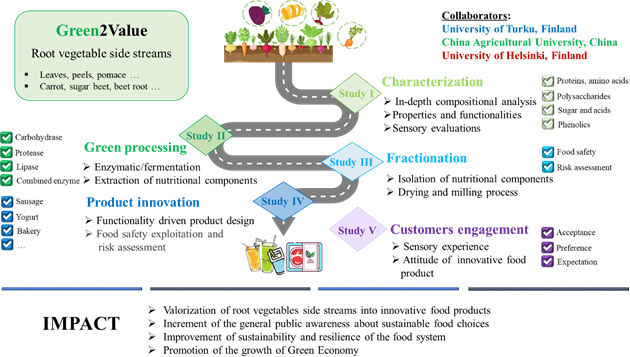Green2Value project studies root vegetable side streams
Rapid growth of global population leads to expansion of food processing industries, generating enormous amounts of agricultural side streams. Root vegetables are the most produced vegetable crops in the world, their side streams are great source of proteins, dietary fiber and bioactive compounds. At present, little is known of using these side streams into human diet, due to the research gap of valorization between the in-depth knowledge and technologies.
Ying Zhou’s (Food Sciences Unit, Department of Life Technologies, University of Turku) project, Green processing of root vegetable side streams to product innovative value-added product based on the biorefining concept (Green2Value), in cooperation with China Agricultural University and University of Helsinki, aims to stimulate the renewal of science to incorporate root vegetable side streams into the rank of novel food by adopting state-of-the-art multi-omics approach and emerging bioprocessing technologies, and multi-disciplinary research platform Flavoria® (smart digital tools). By two-way communication with art consumers, Green2Value will minimize consumers’ distrust of innovative food, nudge general public towards more sustainable food choice and healthy diet, as well as provide a broader perspective on the resilience of food system and circle economy.
Root vegetables are the most produced vegetable crops in the world, with global annual production of over 786 million tones, mainly including carrots, sugar beets, turnips, potatoes, sweet potatoes [1.]. A large volumes of side streams of root vegetables are generated annually, the amount of which is almost equal to the total crop yield. These side streams are rich in nutrients including proteins, lipids, carbohydrates, and bioactive components such as phenolic compounds and carotenoids [2.]. Although some root vegetable side streams have been used as animal feed, the potential value of the biomass has not been explored. For instance, the amounts of crude proteins and dietary fiber from leaves for each hectare of root vegetable cultivation can reach to approximately 600 kg and 1000 kg respectively. Since the plant protein and dietary fiber markets have huge potential with estimated valued at 19 and 20 billion euros by 2031, that means theoretically approximately 5-10% of plant proteins and 20-30% of dietary fiber in the market can be produced from the root vegetable side streams.
The target biomasses of Green2Value are root vegetables side streams such as leaves, peels, pomace of carrot, sugar beet, potato etc. created at farm post-harvest and during industrial processing. Our exploitation on integrated recovery of nutrients by mild processing, yield optimization of target functionality-driven compounds, reduction of undesired compounds to acceptable level in organoleptic quality, as well as food safety and risk assessment of the final product will provide important references and upgrades for root vegetable side streams to join the rank of novel foods.
In order to address the challenges mentioned above, Green2Value will focus on the quality, safety, sustainability of food. Our project will initiate the project with the seed funding from Finland – China cooperation in food and health, stimulate innovation and provide researchers with shared resources, multi-disciplinary and complementary expertise, research network as well as new perspectives. By creating a systematic and GREEN approach, Green2Value will be implemented with the purpose to promote the transition of root vegetable side streams towards VALUE added innovative products, on the basis of a new innovative cooperation of Finland and China partners in long term.
References
- FAOSTAT, “Food and Agriculture Organization of the United Nations,” 2021. https://fao.org/faostat/en/#data/QCL (accessed Jan. 12, 2022).
- Goneim, F. Ibrahim, and Sh. El-Shehawy, “CARROT LEAVES: ANTIOXIDATIVE AND NUTRITIVE VALUES,” Journal of Food and Dairy Sciences, vol. 2, no. 4, pp. 201–211, 2011, doi: 10.21608/jfds.2011.81946.


